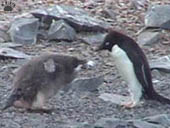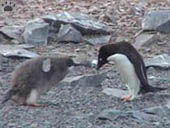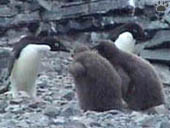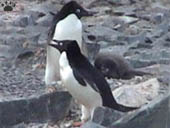 The
penguin colony at Cape Royds on Ross Island, Antarctica
Credit: Peter West, National Science
Foundation
The
penguin colony at Cape Royds on Ross Island, Antarctica
Credit: Peter West, National Science
Foundation

Adelie
penguins colony, Hope Bay, Antarctic Peninsula. |

Penguin
droppings are pinkish because of krill pigments.
Hope Bay. |

Adélie
penguin, Hope Bay. |
In the southern part of Scotia Sea, small
Adelie penguin is the most common species. Large colonies
are scattered at South Shetland, South Sandwich, and South
Orkney Islands, but the largest one in the region (well
over 100,000 pairs) is at Hope Bay at the tip of the Antarctic
Peninsula. Most are on rocky flats and slopes overlooking
sheltered bays. Unfortunately, such places are often chosen
for research stations, and some colonies have already been
destroyed completely or partially.
|

Adélie
penguin, Hope Bay. |
 Adelie
penguin mountaineering, Hope Bay..
Adelie
penguin mountaineering, Hope Bay..
|

"Penguin highway", Hope Bay. |
Some colonies are a mile or more from
the shore. "Penguin highways" - well-used trails
from the beach to the breeding grounds - are always fun
to watch. On snow or ice, the birds often toboggan along,
or use their beaks as icepicks. They feed in huge flocks
close to shore, mostly at night. Krill is their main food.
Unlike most other penguins, they don't come back to colony
to molt, congregating instead on ice floes and small icebergs.
In winter, they migrate
to the edge of pack ice. |

Adelie penguins on the "highway", Hope Bay. |

Adélie
unge,
Hope Bay. |
Adelie penguins' nests are tiny pebble-laid
depressions. They lay two eggs. In late summer, you can
often see pairs of chicks chasing their parents around,
demanding to be fed. Like in most other penguin species,
half-grown chicks form creches - densely packed aggregations,
often enormous, where they huddle together for warmth. Their
parents somehow find them among thousands of other chicks.
|

Adélie
unge,
Hope Bay. |
 |
 |
|
Adelie penguin chicks, Hope Bay.
|

Molting Adelie penguins on an iceberg, Bransfield Strait

Adelie
penguins on the ice of McMurdo Sound.
Credit: Peter West / National Science
Foundation
Adelie penguins prefer regions with sea ice coverage nearby. That
is because their main food is the Antarctic
Krill, which again
require sea ice in order to breed successfully. So with global warming,
which are increasing in the Antarctic, this is now a great
treat to the Adelie penguin.
text:
www.photovolcanica.com
 Adelie
penguin - overview
Adelie
penguin - overview
BBC Natural History Unit
http://www.arkive.org/adelie-penguin/pygoscelis-adeliae/video-09b.html
 Adélie
pingviner (Pygoscelis adeliae), Hope Bay, Antarctic Peninsula.
Adélie
pingviner (Pygoscelis adeliae), Hope Bay, Antarctic Peninsula.
Those penguins probably taste well, as they are hunted by both leopard
seals and killer whales.
Also a favourite food for
Skuas and Giant Petrels are their eggs.
text:
www.photovolcanica.com
All
pictures and text on this page, except if otherwise stated,
Copyright
© Vladimir Dinets
|


























